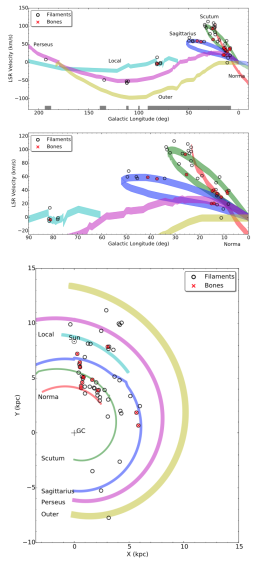A team of scientists has now uncovered half of the entire “skeleton” of the Milky Way, using an automated method to identify large filaments of gas and dust hiding between stars in the galactic plane.

Galactic distribution of 54 newly discovered filaments, plotted along with colored lines indicating six relevant spiral arms in our galaxy. The upper two plots show the consistency of the filaments’ motion with the spiral arms, while the lower shows their location within the galactic plane. [Wang et al. 2016]
The Search for Nessie and Friends
The Milky Way’s interstellar medium is structured hierarchically into filaments. These structures are difficult to observe since they largely lie in the galactic plane, but if we can discover the distribution and properties of these filaments, we can better understand how our galaxy formed, and how the filaments affect star formation in our galaxy today.
Some of the largest of the Milky Way’s filaments are hundreds of light-years long — like the infrared dark cloud nicknamed “Nessie”, declared in 2013 to be one of the “bones” of the Milky Way because of its position along the center of the Scutum-Centaurus spiral arm.
Follow-up studies since the discovery of Nessie (like this one, or this) have found a number of additional large-scale filaments, but these studies all use different search methods and selection criteria, and the searches all start with visual inspection — by humans — to identify candidates.
What if we could instead automate the detection process and build a homogeneous sample of the large filaments making up the skeleton of the Milky Way?
Automated Detection
This is exactly what a team of astronomers led by Ke Wang (European Southern Observatory) has done. The group used a customization of an algorithm called a “minimum spanning tree” — the technique used to optimize the cost of internet networks, road networks, and electrical grids in our communities — to perform an automated search of data from the Bolocam Galactic Plane Survey. The search was designed to identify long filaments that are coherent both in physical and velocity space.
Using this method, Wang and collaborators found a total of 54 large-scale filaments that met all of their criteria. The survey covered nearly half of the galactic plane, and the team estimates that there may be a total of ~200 large-scale filaments like these in the Milky Way.

Histograms of the mass and length of the newly discovered filaments (N=54). The distributions for the filaments that are bones (N=13) are overplotted in red. [Adapted from Wang et al. 2016]
A Catalog of Bones and More
The authors generated a catalog of the newly discovered filaments, determining properties like their masses (1,000–100,000 solar masses), lengths (30–900 light-years), aspect ratios, temperatures, and more. They then used this catalog to make several statistical observations:
- The filaments are widely distributed across the galactic disk, with roughly 50% located within 65 light-years of the galactic plane (for reference, the Sun is 82 light-years “above” the galactic plane).
- Roughly a 1/3 of the filaments are part of the Milky Way’s skeleton, lying along the centers of our galaxy’s spiral arms.
- Around 1% of the molecular interstellar medium in our galaxy is confined in large filaments like these.
- The formation of massive stars occurs more favorably in large filaments, compared to elsewhere in our galaxy.
This catalog is an important building block in our understanding of the structure of the interstellar medium of our galaxy. The authors next plan to extend this census to the rest of our galaxy, providing us with the best picture yet of the skeleton of the Milky Way.
Bonus
Check out all 54 of the filaments discovered by Wang and collaborators in the gif below (or follow the link to the article to view the original images)! Submillimeter dust emission is shown in red, and Spitzer/WISE 24/22 µm emission is shown in cyan. The connected dots show how the filament was identified by the minimum spanning tree algorithm.
Citation
Ke Wang (王科) et al 2016 ApJS 226 9. doi:10.3847/0067-0049/226/1/9


